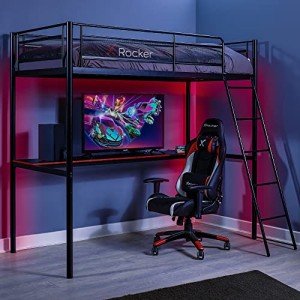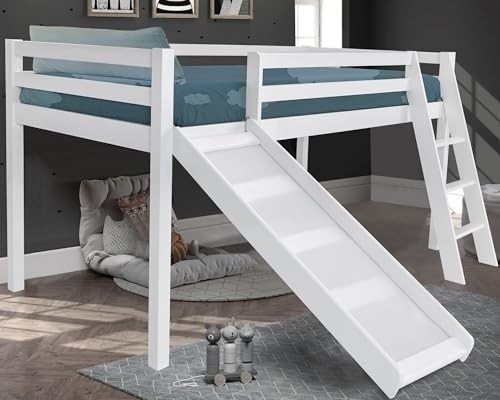The Ultimate Guide to Bunk Beds for Kids: Safety, Styles, and Solutions
Bunk beds have actually long been a popular choice amongst parents looking for to enhance space in their kids's bed rooms. With advantages that exceed their compact style, bunk beds use a fun and practical sleeping arrangement while motivating brother or sister bonding and cultivating imagination. In this extensive guide, we explore different aspects of bunk beds for kids, consisting of safety considerations, various designs readily available, and suggestions for choosing the ideal one for your family.
Why Choose Bunk Beds?
Bunk beds are designed to stack one bed on top of another, using vertical space to produce more room for play and storage. They are particularly useful for households with several kids or restricted bedroom space. In addition, they supply a daring sleeping environment that children typically enjoy.
Secret Advantages of Bunk Beds:
- Space-saving style: Ideal for little spaces or shared spaces.
- Cost-efficient: Often more budget friendly than buying two different beds.
- Motivates social interaction: Promotes bonding among siblings or friends.
- Flexible options: Available in various designs and setups to suit any space design.
Safety First: Essential Considerations
When picking a bunk bed for kids, safety must be the top concern. The following functions are important for ensuring a safe sleeping environment:
Important Safety Features:
- Sturdy Construction: Ensure that the bed frame is made from durable materials such as strong wood or metal.
- Guardrails: Bunk beds need to have guardrails on both sides of the upper bunk to avoid falls.
- Ladder Safety: A sturdy, built-in ladder or stairs with anti-slip rungs is vital for safe access to the top bunk.
- Weight Limit: Check the maker's weight limitation capability for both the top and bottom bunk.
- Bed mattress Size: Use the appropriate bed mattress size as defined by the bed producer to guarantee a tight fit within the bed frame.
Safety Tips for Parents:
- Monitor Sleep Habits: Teach children the importance of not playing on or leaping off the bunk beds.
- Age Appropriateness: Generally, the upper bunk is appropriate for kids aged 6 and older.
- Regular Inspections: Periodically look for any loose bolts, screws, or structural damage.
Designs of Bunk Beds
Bunk beds are available in a range of styles, allowing moms and dads to choose one that complements their kid's room decoration while meeting particular needs. Below are some popular designs:
Popular Bunk Bed Styles:
- Traditional Bunk Beds: Simple and classic designs made of wood or metal with no additional functions.
- Loft Beds: Features a raised leading bunk with space underneath for a desk, play area, or extra storage.
- L-Shaped Bunk Beds: Arranged in an L-shape, frequently ideal for corner spaces and can have additional storage alternatives.
- Twin over Full Bunk Beds: A twin bed on the top and a bigger full-sized bed on the bottom, accommodating children or teens of various ages.
- Triple Bunk Beds: Designed to fit 3 beds in a single footprint, perfect for bigger families or pajama parties.
A Comparison of Bunk Bed Styles
| Bunk Bed Style | Description | Best For |
|---|
| Traditional | Timeless style with 2 stacked beds | Standard bed room setups |
| Loft Bed | Raised bed with usable space underneath | Research or play areas |
| L-Shaped | Bunk beds organized in an L-shape | Corner areas |
| Twin over Full | Twin bed on top, complete bed listed below | Various age brother or sisters |
| Triple Bunk | Three stacked beds | Large households or pajama parties |
Selecting the Right Bunk Bed
When browsing for the perfect bunk bed, think about the list below factors to guarantee you make an informed decision:
Key Factors to Consider:
- Room Size: Measure the space dimensions to determine the proper size and height of the bunk bed.
- Kid's Age: Consider the age of your kid(ren) when selecting a style and safety functions.
- Functionality: Think about just how much storage or play space you require and whether the bunk bed ought to serve extra functions.
- Spending plan: Set a budget that consists of not just the bunk bed however likewise the required mattress and devices like bedding or safety gates.
FAQs About Bunk Beds for Kids
1. What age is appropriate for a kid to sleep in the top bunk?
Typically, kids aged 6 and older ought to be able to securely sleep in the top bunk, though you should always consider your child's maturity level.

2. Are bunk beds safe for toddlers?
It is not advisable for toddlers or extremely kids to oversleep the leading bunk due to the risk of falling.
3. How do I keep the bunk bed?
Inspect the bed regularly for any signs of wear and tear, tightening up screws, and cleaning the bed mattress to ensure extended security and resilience.

4. Can I convert a bunk bed into two different beds?
Many bunk beds are designed to be convertible, allowing you to separate the beds when needed. Examine the manufacturer's specifications before acquiring.
5. How can I make the most of space in a bunk bed space?
Make use of under-bed drawers, shelves, or lofted designs to produce extra storage solutions in a room with a bunk bed.
Bunk beds use a wonderful mix of fun, performance, and space-saving energy, making them an ideal option for young households. By considering security features, different designs, and practical elements such as space size and age suitability, parents can choose the best bunk bed for their kid's needs. With the right choice, bunk beds can change a bedroom into a wonderful space that motivates play, creativity, and bonding amongst brother or sisters. Always keep in mind to focus on safety and maintenance to make the most of this distinct sleeping plan.